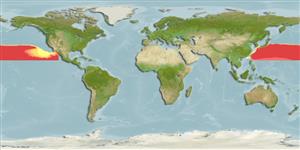>
Aulopiformes (Grinners) >
Notosudidae (Waryfishes)
Etymology: Ahliesaurus: Because of Dr. Ernest Ahli, born in Berlin, 1898 + Greek, sauros =lizard (Ref. 45335).
Eponymy: Dr Christoph Gustav Ernst Ahl (1898–1945) was an ichthyologist, herpetologist and aquarist. [...] (Ref. 128868), visit book page.
Environment: milieu / climate zone / Tiefenbereich / distribution range
Ökologie
seewasser bathypelagisch; tiefenbereich 0 - 3000 m (Ref. 58018). Deep-water; 43°N - 18°N, 105°E - 110°W
Indo-West Pacific: widely distributed in the tropical waters. Eastern Pacific: off central Baja California, Mexico (Ref. 35934).
Size / Gewicht / Alter
Geschlechtsreife: Lm ? range ? - ? cm
Max length : 21.0 cm SL Männchen/unbestimmt; (Ref. 559)
Meso- and bathypelagic ; larvae at 0-600 m, adults at ca. 200-2000 m (Ref. 58302). Synchronous hermaphrodites (Ref. 35934). Oviparous, with planktonic eggs and larvae (Ref. 35934).
Life cycle and mating behavior
Geschlechtsreife | Fortpflanzung | Ablaichen | Eier | Fecundity | Larven
Masuda, H., K. Amaoka, C. Araga, T. Uyeno and T. Yoshino, 1984. The fishes of the Japanese Archipelago. Vol. 1. Tokai University Press, Tokyo, Japan. 437 p. (text). (Ref. 559)
IUCN Rote Liste Status (Ref. 130435: Version 2025-1)
Bedrohung für Menschen
Harmless
Nutzung durch Menschen
Tools
Zusatzinformationen
Download XML
Internet Quellen
Estimates based on models
Preferred temperature (Ref.
123201): 3.1 - 10.4, mean 5.6 °C (based on 108 cells).
Phylogenetic diversity index (Ref.
82804): PD
50 = 0.7500 [Uniqueness, from 0.5 = low to 2.0 = high].
Bayesian length-weight: a=0.01000 (0.00244 - 0.04107), b=3.04 (2.81 - 3.27), in cm total length, based on all LWR estimates for this body shape (Ref.
93245).
Trophic level (Ref.
69278): 3.3 ±0.4 se; based on size and trophs of closest relatives
Widerstandsfähigkeit (Ref.
120179): mittel, Verdopplung der Population dauert 1,4 - 4,4 Jahre. (Assuming tmax>3).
Fishing Vulnerability (Ref.
59153): Low vulnerability (16 of 100).
🛈
